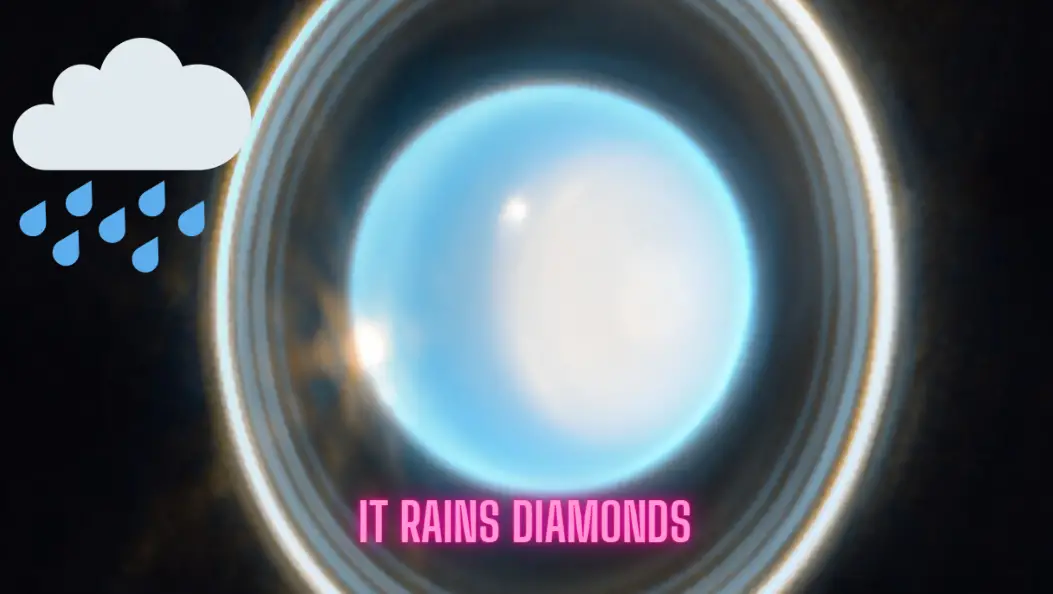Diamonds have always been considered symbols of richness as well as beauty and rarity. Over the course of many centuries, our fascination with these priceless gems has only grown. Most of the time, when we think of diamonds, we see them as being embedded in expensive jewelry or discovered deep under the Earth’s crust. In spite of this, during the past few years, researchers have uncovered an astounding discovery: there is a planet in our solar system where diamonds fall from the sky. Uranus is the name of this particular planetary body.
Uranus is a fascinating planet that is located in the solar system seventh from the sun. It is frequently referred to as the “ice giant” due to the fact that the majority of its composition consists of various types of ice, such as water, ammonia, and methane, with only a small rocky core. The planet Uranus, with its sub-zero temperatures and immense atmospheric pressure, is the ideal place for the production of diamonds due to the unusual combination of extreme conditions that exist there.
This amazing occurrence may be traced back to the make-up of Uranus’s atmosphere, which plays a pivotal role in its development. Methane, which is found in high concentrations in the atmosphere of the planet, has the ability to absorb red light from the Sun, which results in Uranus having its characteristic blue-green hue. As sunlight travels through the atmosphere, the energy contained in the light that is absorbed by the gas molecules causes the methane molecules to split apart, resulting in the production of carbon atoms.
After that, the atmosphere of Uranus places a tremendous amount of pressure on these carbon atoms while also exposing them to extremely low temperatures. Diamond crystals are formed when atoms of carbon meet together at a pressure that is millions of times higher than the atmospheric pressure on Earth. This occurs at depths that are around 8,000 kilometers (5,000 miles) below the cloud tops. The diameters of these diamond crystals are estimated to be comparable to that of raindrops or hailstones, indicating that they are relatively small.
As the diamond crystals continue to grow, they make their way down through Uranus’ atmosphere layer by layer, finally reaching the lower regions where the temperatures are moderately higher. It is believed by scientists that the diamond rain originates from this particular place. The diamonds fall to the planet’s solid core like brilliant raindrops, sparkling in the low sunshine as they go. Eventually, they come to rest there.
On the other hand, experiencing this phenomenon of diamonds falling from the sky would be quite difficult. Uranus is situated at a distance greater than 2.7 billion kilometers (1.7 billion miles) from Earth, which makes it challenging to see and investigate in greater depth. Indirectly, scientists discovered the first traces of diamond rain on Uranus using laboratory tests and computer simulations, which allowed them to recreate the severe circumstances that are prevalent on the planet.
It is possible that Uranus is the only planet in our solar system that experiences diamond rain; nonetheless, it is important to note that other celestial bodies in the universe could conceivably contain conditions that are comparable to those on Uranus, which lead to the formation of diamonds. Due to the fact that planets outside of our solar system have similar atmospheric compositions and severe situations, scientists believe that certain exoplanets, also known as planets outside of our solar system, could likewise experience diamond rain.
The enormous variety and sophistication of our world are brought into sharp relief by the recent finding of diamond rain on Uranus. It serves as a reminder that beyond the boundaries of our own world there are yet an infinite number of wonders waiting to be discovered. It is possible that one day we will have a better comprehension of these faraway worlds and the astonishing occurrences that take place within them as a result of the continuous advancement of our knowledge and technology.
Therefore, the next time you find yourself admiring a diamond, keep in mind that there is a planet in our very own solar system where diamonds fall from the sky in the form of rain. Uranus is an example of the vastness and beauty of the universe since it possesses a one-of-a-kind combination of characteristics, including an icy composition, harsh circumstances, and an atmosphere studded with diamonds.
![]()
